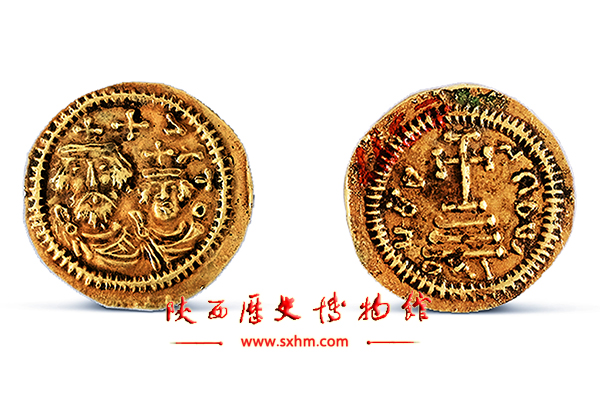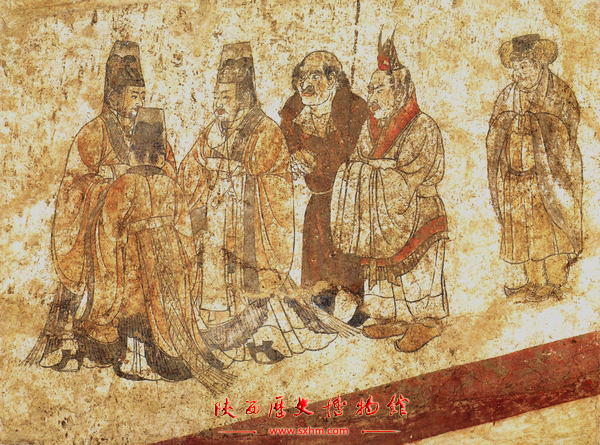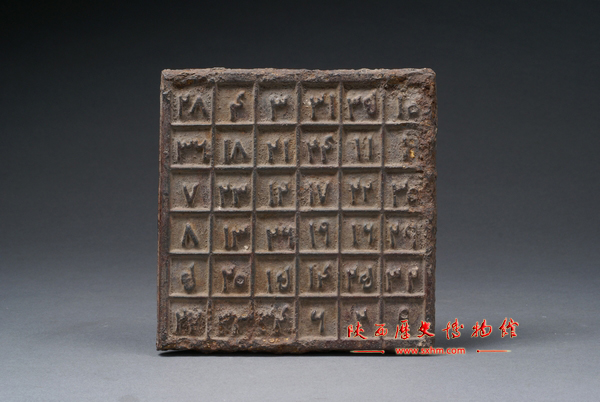The Prosperity of the Silk Road in the Tang Dynasty

Figures of the people from western regions in Chang’an City in the Tang Dynasty
Due to the effective governance in the Tang Dynasty, western regions were no longer under the situation of having a great number of small countries which making the Silk Road in the Tang Dynasty smoother than that in the Han Dynasty. What is more, the people in the Tang Dynasty were better at recognizing and communicating with the world and they were thus more passionate and more curious than people in Han Dynasty when the Silk Road was first opened. This made the Silk Road in the Tang Dynasty more prosperous than ever. The Tang Dynasty communicated with over 300 countries and regions, with ambassadors coming one after another each year; the diplomat in the Tang Dynasty, Wang Xuance, had been to India three times and exerted a significant role over diplomatic actions in foreign countries, which guaranteed the peace and tranquility on both sides of the Himalayas. The prosperity of the Silk Road was centrally reflected in the Tang King West Market in Chang’an City.

Foreign currency unearthed from the relics of Chang’an City

Tang King West Market Museum
Located in the southwest of the imperial city of Chang’an City in the Tang Dynasty, Tang King West Market was the largest commercial center in Chang’an City as well as the largest market in the world at that time. Tang King West Market was 1,031 meters from south to north and 927 meters from west to east, covering nearly one square kilometer, according to the archaeological survey. There were two streets as wide as 16 meters in a north-to-south direction and east-to-west direction respectively, with four streets making the shape which divided the whole market into nine rectangular regions, among which, the distance between the eastern and western streets was 327 meters while that of the southern and northern one was 309 meters. Each of the four sides of the nine regions in Tang King West Market was streets and the surroundings of each region faced a street, which facilitated transactions. There were also small internal lanes within each region. There were altogether 220 types of trade and thousands of stores in Tang King West Market, including wine, clothing, drugs, ancient jade, jewelry and iron. Tang King West Market hosted all kinds of merchants and tens of thousands of them were local residences. The peak of passenger flow can reach to 150,000 passengers each day.
As the international trade market at that time, Tang King West Market was the main place for economic and trade transactions and the largest article distribution center. A series of protection, encouragement and favorable measures were taken in the Tang Dynasty to promote the prosperity and development of transactions in this market. Therefore, Tang King West Market and the cluster of people from western regions were featured as an “economic special zone” to some extent. As the window of exchange between China and foreign countries and international trade, the Tang King West Market, as well as the cluster of people from western regions also witnessed a period of splendid times characterized by strong national power, a prosperous economy, pure politics, tolerant culture and a harmonious nation.
The Tang King West Market was totally destroyed in one day due to a fire in June in the ninth year of Taihe (835AD). Since then the grand scenery of the splendid Tang King West Market could be known only from books. Since 1960s, archaeologists have conducted several investigations and excavations. With the great efforts, the archaeologists confirm the prosperity and resplendence of the Tang King West Market. The Tang King West Market Museum, completed in April 2010, allows people to feel its prosperity and resplendence from the original site. The architectural remains are protected at the original address. In addition to the remains of the South Vietnam Palace, showcased and protected with glass in Guangzhou, the Tang King West Market is the second one that is showcased by protecting the original address in Xi’an City. In addition, the Shaanxi Municipal Government has also included Tang King West Market in the proposed list of application for the “Silk Road” as a world cultural heritage site.
The smooth and prosperous Silk Road resulted in the powerful Tang Dynasty which also attracted a growing number of foreigners to come to Chang’an for studying and to enjoy their lives. It was the dream of many foreigners to be sent to Chang’an for diplomacy or to study. If a majority of the people engaged on the Silk Road in the Han Dynasty were merchants and soldiers, and communication focused on the economy, people who were active in the Silk Road in the Tang Dynasty were more than that; additionally, the number of people who sought cultural communication was on the rise. The influence was far-reaching and significant.

Wall painting describing officials in the Tang Dynasty receiving foreign ambassadors
China is separated from Japan by a narrow strip of water but China’s highly developed culture exerted a significant role in Japan, which imitated and absorbed Chinese characters, Confucianism, ceramics, the calendar and even the style of eating and playing. The process in which Japan enjoyed favor from China was realized by sending a large number of ambassadors and students. In the Tang Dynasty, there were 19 groups of Japanese ambassadors sent to Chang’an, the total number of which was several thousand people. The students coming with the delegations learned the culture of the Tang Dynasty. Among them there were some prestigious persons, such as Abeno Nakamaro, who finally stayed in China as an official in the Tang Dynasty and spent his lifetime here; the student Kibi Makibi and the monk Kukai made great contributions to transmitting Chinese culture after returning to their motherland, which promoted the rapid development of Japanese society and culture; they are all still remembered and respected. Eight most famous monks who came to China for study were called the “Eight Monks in the Tang Dynasty”, among whom, there were six monks who studied in Qinglong Temple in Chang’an and finally obtained the title of master; the Japanese monk Ennin was one among the eight. He had been in the Tang Dynasty for eight years and wrote the book called Traveling Note in the Tang Dynasty for Learning Buddhism based on his own experiences. The book is honored as the best collection of oriental information by scholars and equal to the Marco Polo’s Travel in terms of importance. Ino Manari’s Epitaph, unearthed in Xi’an recently, shocked both China and Japan, since Ino Manari actually came to China as a Japanese ambassador and finally died in Chang’an. Ino Manari’s Epitaph is the only epitaph of a foreign ambassador in China unearthed at present and it is thus definitely precious.
Shilla (now the southeast part of the Korean Peninsula) was close to Tang domain and people there were quite enthusiastic about learning from the Tang Dynasty. The total number of students coming to the Tang Dynasty was more than that of other countries. Many students from Shilla became successful candidates in the highest imperial examination in Tang Dynasty. In particular, both Chinese and Japanese scholars were greatly shocked by the accomplishments of Cui Zhiyuan, one of the most prominent figures.
Central Asia, West Asia and South Asia were also very passionate in communicating with the Tang Empire. At the defining moment when Persian Sassanian was stuck in crisis, it thought of seeking aid from the powerful eastern country; the last king Peroz and his son Narses came to Chang’an and spent their rest lifetime here. Their names were carved on two of sixty one stone portraits buried within the Qianling Mausoleum. In 635AD, the Persian Alopen came to Chang’an with the mission of Nestorianism and Emperor Taizong of Tang sent Fang Xuanling to welcome him in the west suburbs with honor guards, which indicated not only respect for the religions of foreign countries but also their mutual relationship. Nestorianism in the Tang Dynasty can still be traced, i.e., the famous monument called The Nestorian Monument in China, involved in the spread of Nestorius Christianity is still discussed and studied within academic circles of different countries. Many Persians migrated to Chang’an for business or study and they then married and had children. Some of them served as officials and later were granted citizenship by the Tang government.
There were once several thousand people being granted citizenship. Su Liang, a descendent from Persia, who lived in Chang’an for quite a long time, 200 years after the downfall of Persia, wrote an epitaph for his wife in both Chinese and old Persian after his wife dead; it is stored in Xi’an Beilin Museum. Li Xun, whose origin was Persian, was a very famous poet in the Tang Dynasty. Persian merchants brought a lot of precious jewels and their abilities to process gold and silver wares, etc., were also transferred to the Tang Dynasty without any reservation. Many scholars have counted scientific projects between China and other countries, the number of which was as many as one hundred, while Persia served as the main focus for imports and exports.

Golden and silver wares of the Tang Dynasty manufactured due to the influence of the Sogdiana Persian golden and silver wares —Octagonal silver cup with lady pattern and hunting scene and golden cup with Capricorn pattern
Both China and India were the countries with an ancient civilization in the world and both regarded the other one as a powerful country with civilization and wealth. Besides sincere respect, the two countries also pursued something spiritual mutually; as a result, the people from both countries tried their best to go to the other country for academic discussion and cultural exchanges and finally became the friendly messengers for communication. Among them, the most important person is Xuan Zang. To clarify the doubt on Buddha nature, Xuan Zang decided to travel to the west from 627AD to 645AD and sought for the essence in India fearlessly. Xuan Zang walked to India and finally obtained “real scripture”. He brought 657 pieces of scriptures back, which was unprecedented. He had translated scriptures for 19 years with 75 books and 1,335 volumes finished. He achieved resplendence and created the peak of Chinese Buddhism translation career. During the process of translating scriptures, Xuan Zang changed the condition in previous scripture translation such as loss, disorder or frequent errors with the excellent family background and profound traditional culture accumulation, making the newly-translated one more complete, clearer and relatively accurate and greatly improving the local abilities of scripture translation. It was also because of his work Xuan Zang obtained his unshakable status along the Chinese translation history. Xuan Zang united a large batch of exceptional monks during the process of translating scriptures and giving lectures in Da Ci’en Temple which was made as the world-famous Buddhism center as a result. He also wrote what he saw and experienced along the travel in the book Traveling Records of the Western Regions in the Tang Dynasty, which is highly evaluated by international academic circle. While bringing back a large number of scriptures from India, Xuan Zang also took with Chinese culture as exchange, making great contributions to cultural communication between China and India. Xuan Zang was widely known to all in India. Indian history would become blank, to some extent, without the record by Xuan Zang.
There were also many Indians who came to Chang’an in the Tang Dynasty. In particular, the Indian Qutang Family, which was good at astronomy, and their offspring served as the directors of national astronomy and fulfilled other senior duties, and wrote the monumental works on astronomy called Treatise on Astrology of the Kaiyuan Era. Three Indian monks, Subhakarasimha, Vajrabodhi and Amoghavajra, came to the Tang Dynasty during Kaiyuan Period (713~741AD) and they were all prestigious scholars and translators. They introduced the Buddhist doctrine, painting, sculpture, mathematics, rhyme, logics and medical science to Chinese people together with other preachers. In addition, they established Esoteric Buddhism in Da Xingshan Temple in Chang’an, which made great contributions to Chinese culture. For example, the direct results of the grotto arts from India was enriching materials, styles and expressive force of Dunhuang, Longmen and other art treasure houses, and updating their artistic levels. After being spread to China, the tower—the most vital building in Indian Buddhism, became the most common landmark temple building in China as well as one of the main forms for classic Chinese buildings.

Stone Monument of Monk Amoghavajra in the commemoration of Amoghavajra
The Tajik (the old name of Arabia) people also migrated to China and altogether there were 37 groups of ambassadors coming to Chang’an, which was far more than that from Japan. The Tajik people in the Tang Dynasty were officials, merchants or slaves, and the image of “Tajik foreigners” could be commonly seen on cultural relics. In 752AD, the Tang Dynasty was in conflict with Tajik and some paper-making craftsmen migrated to Tajik, introducing paper-making, one of the great four inventions of China to the Arabic areas, from which it was spread to Europe. It influenced the civilization process of the whole world. The symbol and concept of “0” did not exist in the ancient Chinese mathematics and it was later introduced to China from Arabia in the Tang Dynasty, which greatly enhanced abstract thinking and the expression of Chinese mathematics.

Magic Square in Arabic numbers dating to the Yuan Dynasty—unearthed in the relics of Anxi Palace in the Yuan Dynasty in the eastern suburbs of Xi’an; there were five pieces altogether. There were six lines of Arabic numbers arranged vertically and horizontally, ranging from 1 to 36 without any repetitions. Each line, no matter horizontally, vertically, or diagonally, adds to 111, which made it magic; it was thus called the magic square. Meanwhile, the numbers used were ancient Arabic numbers, the source of which attracted the attention of different parties; some scholars thought it was related with Macro Polo.
While learning about the cultures in the Tang Dynasty, the people who migrated to Chang’an also influenced the local people as well as the whole society on ideology, spirit, culture and other feats. More migrants and a higher status resulted in a larger influence on the local society. There were a large number of poems in the Tang Dynasty reflecting the relationship between the Tang Empire and the foreign countries. It can be said that all of these poems decorate the Silk Road as a colorful and splendid corridor. “The local shopkeeper invited the customer to taste his wine for free to show the great hospitality” could be commonly seen on the streets of Chang’an. Wine from the western regions became a common material for Li Bai, a wine enthusiast and poet, as well as other poets. It is also one of the powers for creation; legend has it that there was a prime minister (in feudal China) on his way to the court; he suddenly smelt a delicious pancake introduced from foreign countries and could not help getting some to eat. He was mocked for his discourtesy but this could fully demonstrate how the foreign life style had penetrated into Chang’an City. Enjoying foreign songs and dances, wearing clothes with foreign styles such as the lapel gown, as drawn in wall paintings and seen on pottery figurines, were all quite fashionable at that time. The openness and tolerance at that time can be said to have made the Tang Dynasty more acceptable of foreign cultures, which, as a result, made the Tang Dynasty more prosperous and resplendent.


